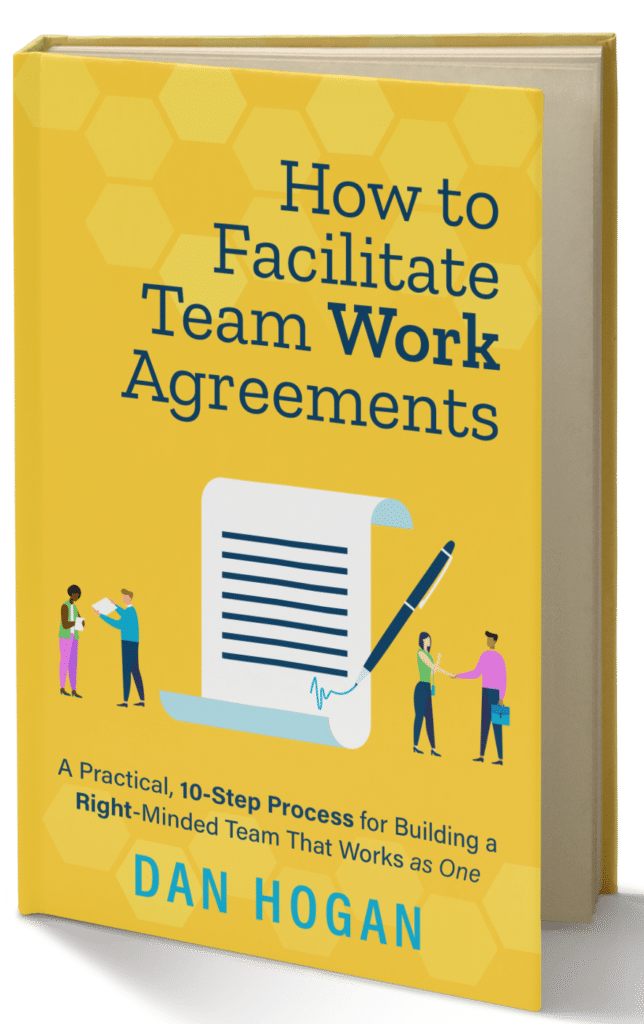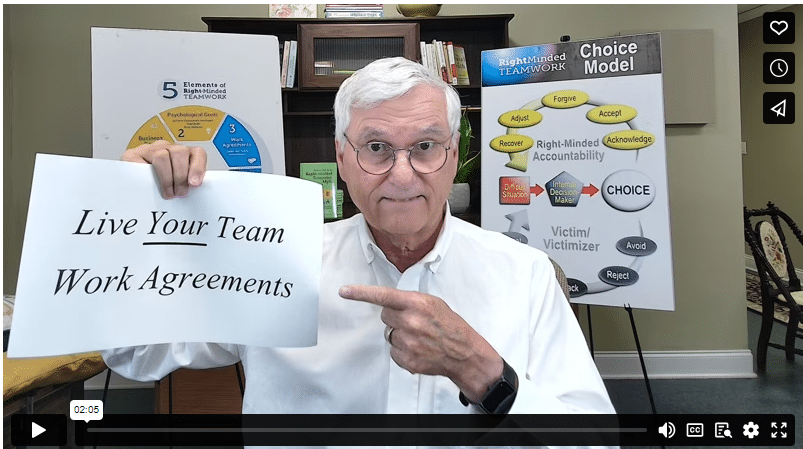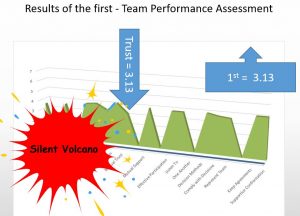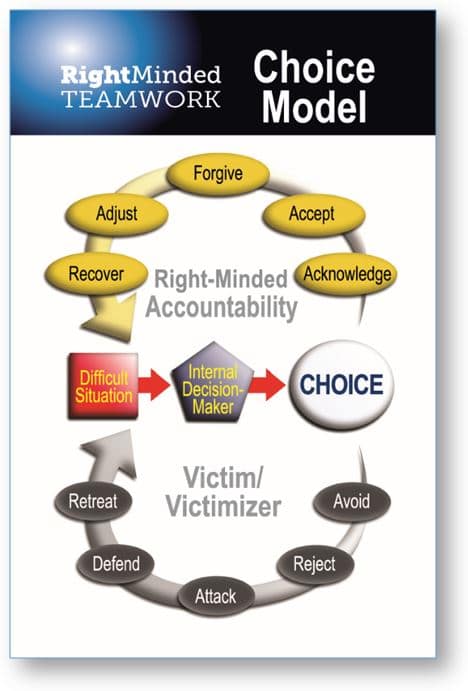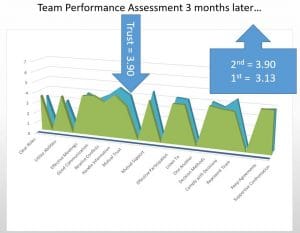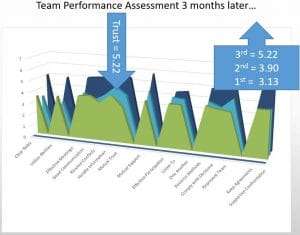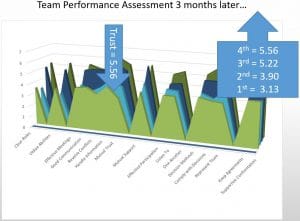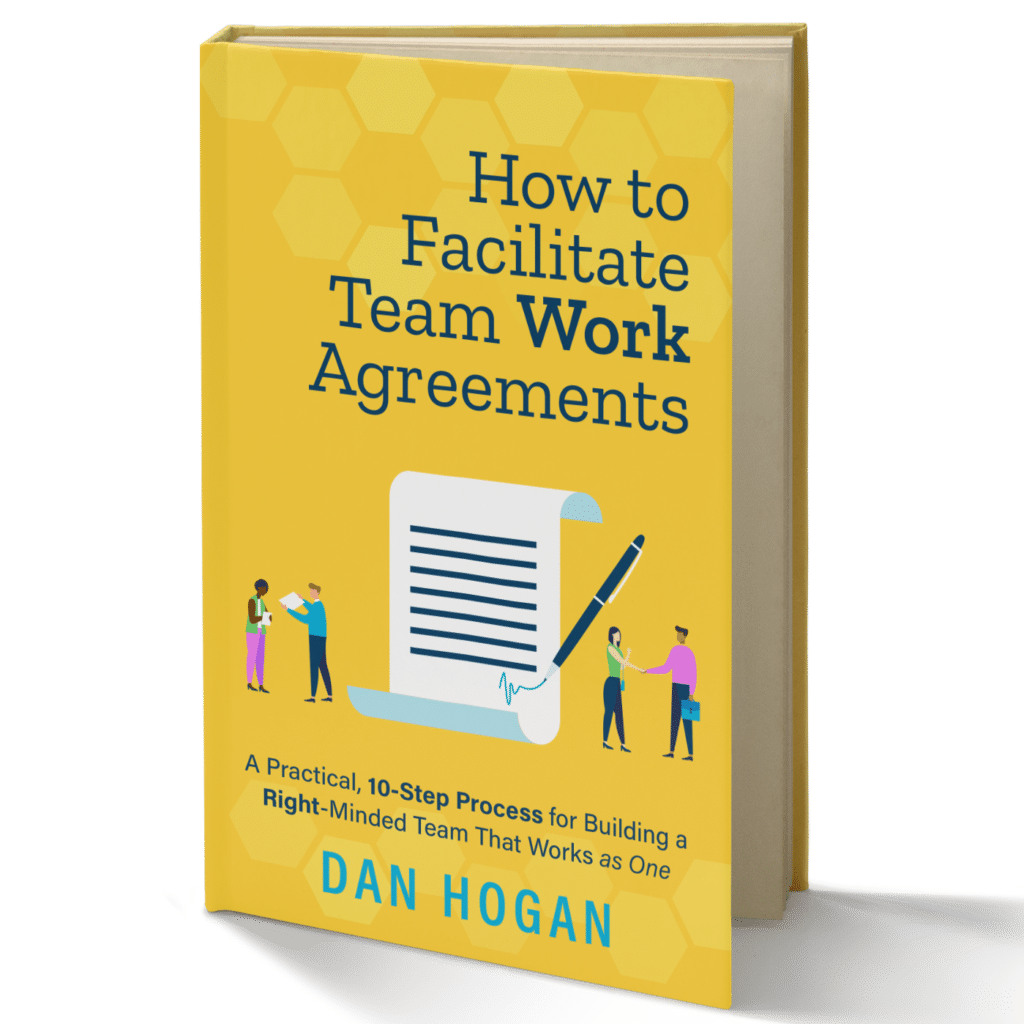Creating and following team working agreements is a key characteristic of successful teams.
Why? Because it increases the likelihood your team will meet or exceed its customers’ expectations.
In this article, you will learn 1) HOW one team succeeded with their Work Agreements, 2) WHAT are Agreements and 3) WHY team Agreements work.
Table of Contents
These People Came Together with Their Work Agreements
Their Story: How & Why They Created Their Agreements [which includes a Moment of Reason]
What Are Work Agreements Plus Two Real Examples
Video 2:05 Minutes – How to Facilitate Work Agreements
These People Came Together with Their Agreements
One year after their Work AgreementsA Work Agreement is a collective teammate promise to transform non-productive, adversarial behavior into collaborative teamwork behavior. More workshop, which included a “Moment of Reason,” this team had completely turned around.
During their workshop the year before, they had recommitted to their shared goals and created powerful Work Agreements to solve several team challenges.
After honoring their Work Agreements for a full year and tracking their results, they not only felt like a true team but had the data to prove it. In just a year, they experienced the following:
- 78% increase in teammate trust
- 46% increase in mutual team member support
- 61% increase in complying with decisions
- Over $350,000 in savings.
This was a Field Operations team for Chevron in the Gulf of Mexico waters. They were responsible for supporting all the company’s offshore oil platforms.
Before I met them, they were technically competent, but they were unhappy and far from productive. Worst of all, two-thirds of the team members were arrogant and aggressive.
They turned to me, Dan Hogan, for facilitative support.
NOTE: To come back to the story later, click here to SKIP to What are Work Agreements & Two Examples
Their Story: How & Why They Created Their Agreements
In their first team-building workshop, the team created two Work Agreements. Three months later, those Agreements led to a Moment of Reason.
I will explain what a “Moment of Reason” means, but first, let me share their story chronologically.
Before any team-building workshop, an effective facilitator will first diagnose the team’s current performance level. That means using one of two methods.
- Administering a survey
- Interviewing teammates
With this team, I chose to do both.
First, I conducted a Team Perception Survey so I could understand how they assessed their current performance.
Teammate trust, one of the 20 performance factors measured in the survey, came in low, just 3.13 out of a possible 7.00. From that measure, I knew things were pretty bad. We had our work cut out for us.
After studying the survey results, I then interviewed all nine teammates individually. During the interviews, I learned about several teamwork dysfunctions. A number of teammates commented about the tendency of several other teammates to “explode” when they became frustrated. Some even called it an Ego Attack. For this team, I called their behavior the …
Silent Volcano Dysfunction
Here’s What Happened Next
To clarify the pattern, in the first workshop, I presented a Silent Volcano graphic illustration of their behavior. Take a moment and read it now. I bet you have seen this pattern before, too.
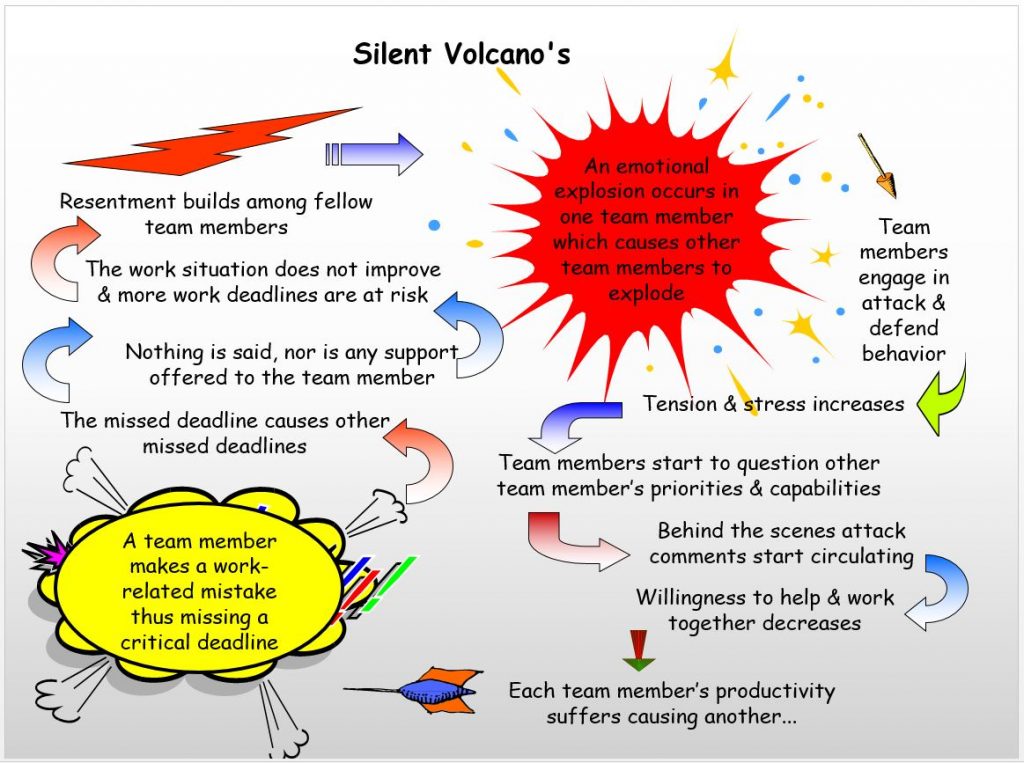
Moreover, they were willing to address their differences to make it happen.
Consequently, they chose two topics for their Work Agreements:
- Lack of trust
- How to become a successful, self-managing team [this goal was assigned to them without their input]
When the team saw this graphic, they knew it described their behavior. They realized and accepted that they, as a team, had to change.
After they chose their first two topics, I presented the Right-Minded Choice Model.
The Model teaches that we always only have two choices as to how we respond to difficult situations:
- in an accountable way [upper loop], or
- as a victim [lower loop].
The team liked the Right Choice Model. They believed it would help them resolve their two issues.
After a short discussion, they agreed to act and behave in an accountable way. Moreover, they actually agreed on specific behaviors from the Right-Minded Teamwork Attitudes & Behaviors list. Those behaviors played an important role in helping them create two team Work Agreements.
Their First Two Work Agreements
Their first Work Agreement was a behavioral Agreement that addressed how they would increase trust. The other was a process Agreement to help them succeed in becoming a self-managing team.
The team agreed to conduct follow-up team-building workshops once every three months. They asked me to facilitate these workshops and to administer a new survey each time.
I worked with them for two years.
Three months after the first workshop, I administered the second survey. The results already showed improvement. Teammate trust had increased from 3.13 to 3.90 – a decent-sized jump for just three months.
Seeing their growth made teammates even more motivated to continue teamwork improvement.
A Breakthrough “Moment of ReasonWhen you are facing a challenge such as an Ego attack, and you experience a positive and perhaps surprising moment of revelation, clarity, or sanity, you have achieved a moment of Reason. More” at the 3-Month Mark
In the second workshop, the team experienced a pivotal moment of accord around their Agreements. This collective teammate moment was a “Moment of ReasonReason is a mythological character and symbolic guide who shows you how to think and behave in a Right-Minded way. As your Right-Minded teacher, Reason helps you differentiate and choose between Right-Minded and wrong-minded attitudes and behaviors. More.”
A Moment of Reason is a shift in one’s mind.
It is a moment when sanity and good behavior return to the minds of those who have been temporarily out of their right minds.
Their Moment of Reason changed the way these nine teammates treated and worked with each other.
What Happened?
About an hour into the workshop, the team fell back into their old way of interacting. They were once again arguing about something they had addressed three months earlier.
At one point, I was able to interrupt their bickering.
I asked them to pull out their team Work Agreements. They all read them. Then, one teammate said,
“We’ve already agreed how we were to address that issue, haven’t we?”
I replied, “Yes. Now, you only have two choices – be a victim or be accountable. You can argue and fight more, or you can recommit to your Work Agreements.”
In less than a minute, they agreed to recommit to their Work Agreements. It was their Moment of Reason.
It was a perfect example of how teammates, who are out of their minds, can move back into their right minds.
They made this shift quickly and easily, by remembering their team Work Agreements.
For the rest of the second workshop, the third workshop, and beyond, they never slipped back to their old ways.
As the third and fourth surveys showed, the team continued to improve over the next six months.
Click to enlarge the graphics to see their survey results.
Results: 1 Year of Following Their Agreements
A year after establishing their Work Agreements, the team presented the following results to their Senior Leadership Team.
- a 45% total improvement in the 20 team performance factors in the survey
- a 78% increase in teammate trust
- a 46% increase in mutual support
- a 61% increase in complying with decisions
- Over US$350,000 in savings.
Finally, the teammates were happy and productive. Furthermore, their leaders and the team’s customers were also happy. The team continued to improve and work together for another FIVE YEARS. They never returned to their old, dysfunctional ways.
What Are Team Work Agreements?
A Work Agreement is a promise to transform non-productive work behavior. It is not a flimsy ground rule. It is an emotionally mature work performance agreement.
There are two types of Work Agreements:
- A Process Agreement describes who will do what and the respective work methods they will use. This Agreement consequently defines roles and responsibilities, interfaces, and procedures.
- A Behavioral Agreement describes how people will behave while they perform their tasks. This Agreement defines how teammates will resolve difficult issues or interpersonal conflict striving for transparency in all interactions.
Between the two, all teamwork issues are suitable for team Work Agreements.
Two Parts of a Work Agreement
A well-written Work Agreement starts with an Intention Statement. Here is a good example:
1. Each teammate will communicate their thoughts and feelings in an appropriate way.
Each Intention Statement will also have clarifications and/or conditions for acceptance. Here are some examples:
- We follow the spirit and intent of our company values.
- If a teammate is not communicating in an appropriate way, we will call it to their attention.
- We will give positive teammate reinforcement when we see and hear good communication.
Creating team Work Agreements happens in a team-building workshop. In this setting, the team leader and teammates are willing to discuss and agree on work behaviors. They intentionally use Work Agreements to resolve interpersonal or process issues that are hurting the team because they know it will help the team achieve their goals and function better together.
Two Real Team Work Agreements
Below you will find two real examples. The first one is a behavioral team Communication Work Agreement. The other is a process, Decision-Making Work Agreement.
I worked with this team for a few years. They were phenomenally successful Agreements because teammates passionately created and actively lived them day in and day out.
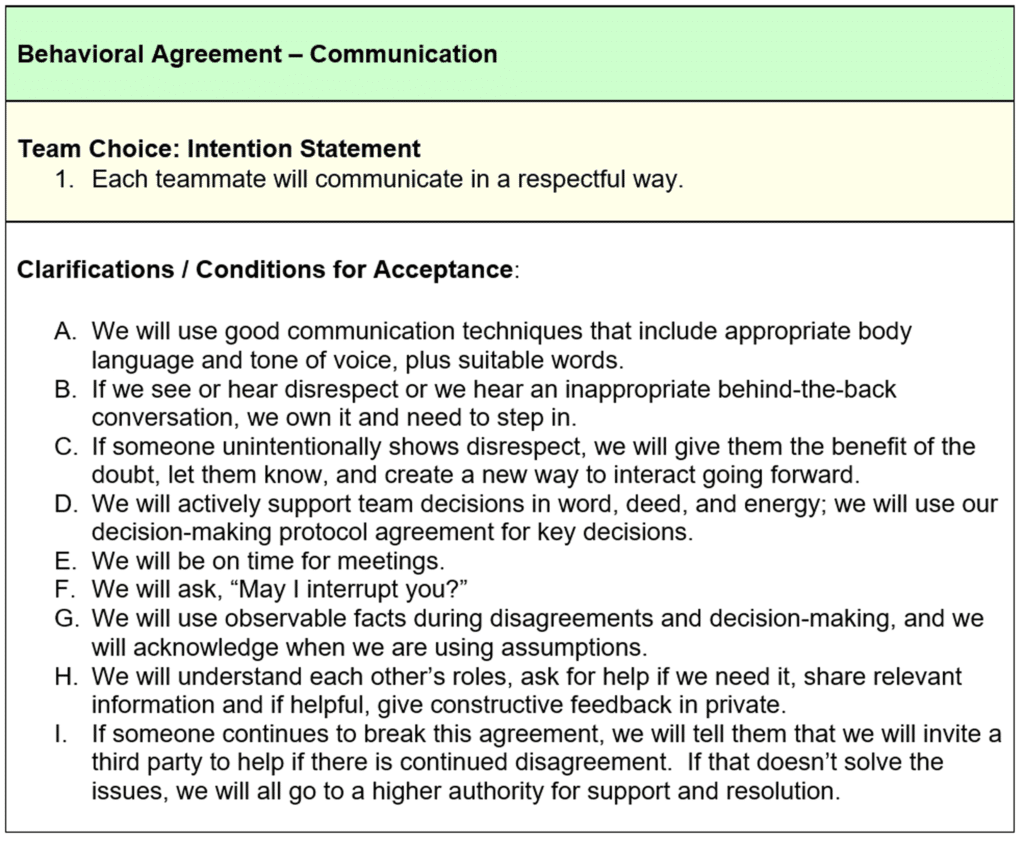
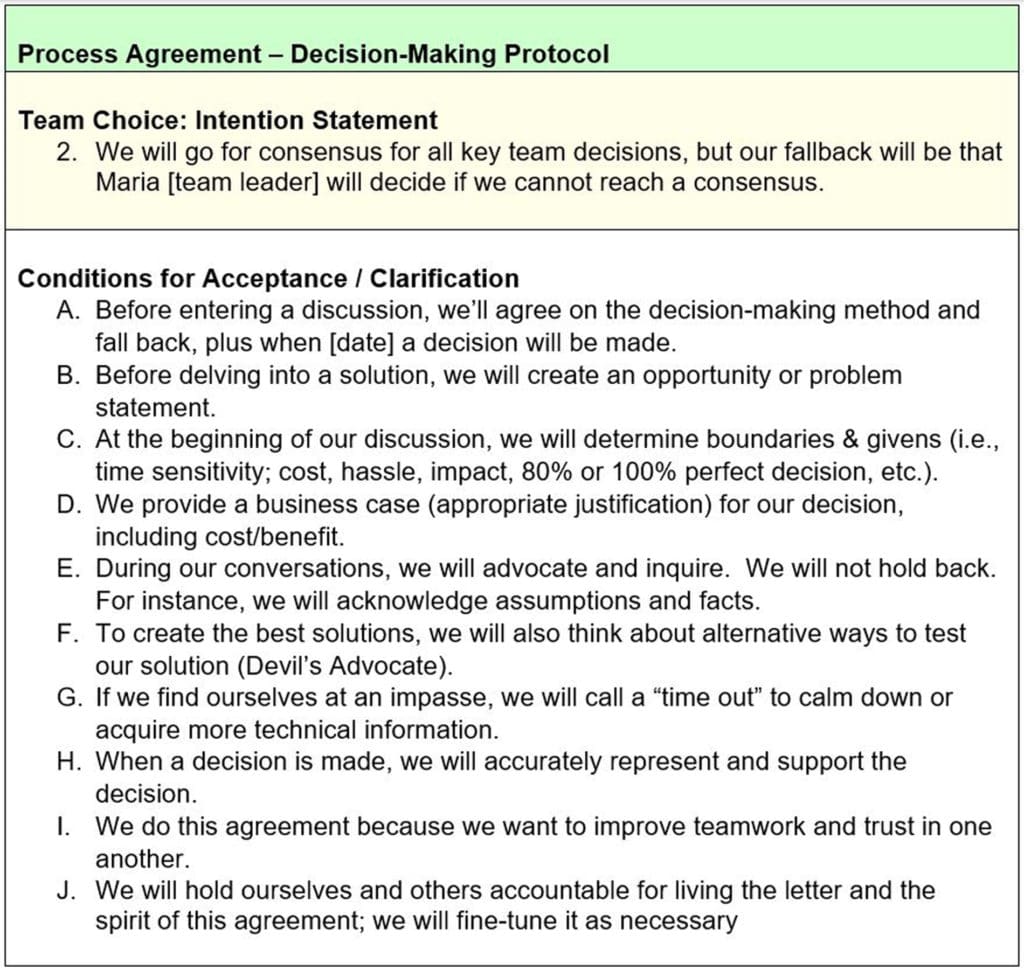
With my guidance, it took this 10-person team about 3 hours to create these two Work Agreements. Use your imagination as to what they said to each other that made this successful agreement.
Why Team Agreements Work
I facilitated over 500 teams in eight countries in my 35-year team-building career. I worked with many of those teams for several years. Every team created some kind of “fit-for-purpose” team Work Agreement and every team grew and succeeded because of it.
Work Agreements work when teammates live and follow them.
Here’s why:
It is not a matter of IF conflict will happen, but WHEN conflict happens among teammates.
This truth alone is enough justification for creating team Work Agreements.
It is far better to have Work Agreements in place before conflict happens. But even if your team is currently in conflict, it is never too late to create and follow Work Agreements.
The team’s compelling story above is a prime example of how Work Agreements help teams. But it is certainly not the only one.
This success can happen in your team, too.
Your Next Steps – 3 Learning Options
- Learn more about the 10 Facilitation Steps in this short article. It will help you decide to buy the book and learn this valuable teamwork tool.
2. Buy the ebook PACKAGE here ar Right-Minded Teamwork includes
- Ebook: PDF & ePub, 266 pages with step-by-step instructions and real-world examples
- Word Document: How to Facilitate Team Work Agreement – Reusable Resources [these are ONLY available here at the Right-Minded Teamwork website]
- PDF: How to Facilitate Team Work Agreements – Resources
3. Buy the Paperback Book at Amazon or Barnes & Noble
How to Facilitate Work Agreements – 2:05 Minute Video
Get Started
In the thirty-five years of my team-building career, I facilitated over 500 teams in varying states of conflict and dysfunction. Every team created Work Agreements of some kind and succeeded as a result.
I know beyond a shadow of a doubt that Work Agreements work when teammates live them. They are right for every team, everywhere, forever. If you use them, I promise they will help make your team(s) and the world a better place.
Let’s get started right now.
May Oneness be With You & Your Teammates 🙏
